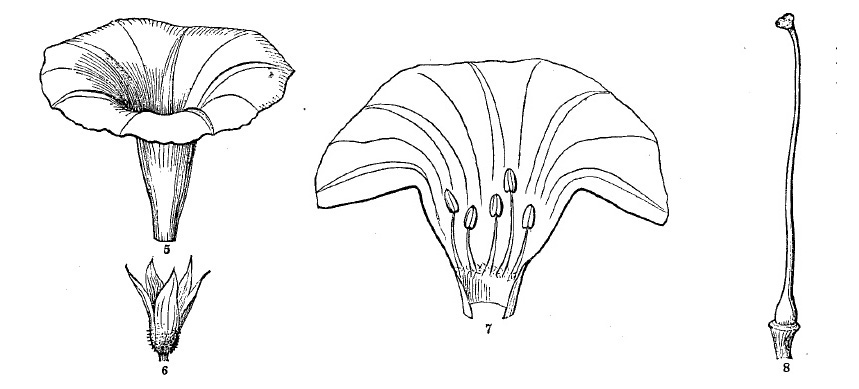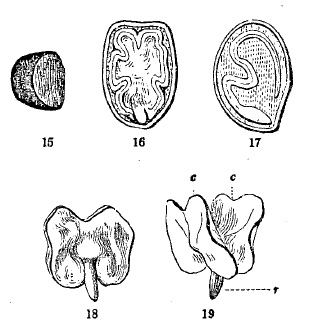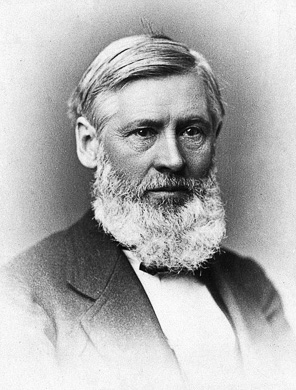BOTANY FOR YOUNG PEOPLE AND COMMON SCHOOLS
How Plants Grow
A Simple Introduction to Structural Botany
by Asa Gray
Originally published in 1858 and now in the public domain.
CHAPTER I.
HOW PLANTS GROW, AND WHAT THEIR PARTS OR ORGANS ARE.
SECTION I. -- The Parts of a Plant.
I. PLANTS are chiefly made up of three parts, namely, of Root, Stem, and Leaves.
These are called the plant's Organs, that is, its instruments. And as these parts are all that any plant needs for its growth, or vegetation, they are called the ORGANS OF VEGETATION.
2. Plants also produce Flowers, from which comes the Fruit, and from this, the Seed.
These take no part in nourishing the plant. Their use is to enable it to give rise to new individuals, which increase the numbers of that kind of plant, to take the place of the parent in due time, and keep up the stock; that is, to reproduce and perpetuate the species. So the Flower with its parts, the Fruit, and the Seed, are called the plant's ORGANS OF REPRODUCTION.
3. The different sorts of Lilies represented on the first page, and the common Morning-Glory on this page, show all the parts.

4. The Root (Fig. 4, r) is the part which grows downwards into the ground, and takes in nourishment for the plant from the soil. It commonly branches again and again as it grows; its smaller branches or fibres are named Rootlets. Real roots never bear leaves, nor anything besides root-branches or rootlets.
5. The Stem (Fig. 4, s) is the part which grows upwards, and bears the leaves and blossoms. At certain fixed places the stem bears a leaf or a pair of leaves.
6. Leaves (Fig. 4, l, l) are generally flat and thin, green bodies, turning one face upwards to the sky, and the other downwards towards the ground. They make the Foliage.
7. The Plant in Vegetation. We see that a plant has a body or trunk (in scientific language, an axis), consisting of two parts, an upper and a lower. The lower is the Root: this fixes the plant to the soil. The upper is the Stem; this rises out of the ground, and bears leaves, which are hung out on the stem in the light and air.
The root takes in a part of the plant's food from the soil; this the stem carries to the leaves. The leaves take in another part of the plant's food from the air. And in them what the roots absorb from the ground, and what they themselves absorb from the air, are exposed to the sunshine and digested, that is, changed into something proper to nourish the plant.
For there is no nourishment in earth, air, and water as they are; but vegetables have the power of making these into nourishment. And out of this nourishment it prepares, the plant makes more growth. That is, it extends the roots farther into the soil, and sends out more branches from them, increasing its foothold and its surface for absorbing; while, above, it lengthens the stem and adds leaf after leaf, or shoots forth branches on which still more leaves are spread out in the light and air.
8. So the whole herb, or shrub, or tree, is built up. A tiny herb just sprouted from the seed and the largest tree of the forest alike consist of root, stem, and leaves, and nothing else. Only the tree has larger and more branching stems and roots, and leaves by thousands.
9. The Plant in Reproduction. After having attended in this way to its nourishment and growth for a certain time, the plant sets about reproducing itself by seed. And for this purpose it blossoms.
Many plants begin to blossom within a few weeks after springing from the seed. All our annuals, of which the Garden Morning-Glory (Fig. 4) is one, blossom in the course of the summer.
Biennials, such as the Carrot, Parsnip, Mullein, and the common Thistle, do not flower before the second summer;
and shrubs and trees, and some herbs, do not begin until they are several years old.
10. The object of the Flower is to form the Fruit.
The essential part of the fruit is the Seed. And the essential part of a seed is the Germ or Embryo it contains.
The Germ or Embryo is a little plantlet in the seed, ready to grow into a new plant when the seed is sown. Let us notice these organs one after the other, beginning with
11. The Flower. Flowers are most interesting to the botanist, who not only admires them for their beauty, the exquisite arrangement and forms of their parts, and the wonderful variety they exhibit, but also sees in the blossoms much of the nature or character of each plant, and finds in them the best marks for distinguishing the sorts of plants and the family they belong to.
So let the student learn at once
12. What the Parts of a Flower are. A flower, with all the parts present, consists of Calyx, Corolla, Stamens, and Pistils.
One from the Morning-Glory (Fig. 4, f) will serve for an example. Here is one taken off, and shown of about the natural size, the corolla, Fig. 5, separated from the calyx, Fig. 6. The calyx and the corolla are the Floral Envelopes, or the leaves of the flower. They cover in the bud, and protect the stamens and pistils, which are the Essential Organs of the flower, because both of these are necessary to forming the seed.

13. The Calyx, a Latin name for "flower-cup," is the cup or outer covering of the blossom (Fig. 6). It is apt to be green and leaf-like.
14. The Corolla is the inner cup, or inner set of leaves, of the flower.
It is very seldom green, as the calyx commonly is, but is "colored," i.e., of some other color than green, and of a delicate texture. So it is the most showy part of the blossom.
Fig. 5 shows the corolla of the Morning-Glory whole. Fig. 7 is the same, split down and spread open to show

15. The Stamens. These in this flower grow fast to the bottom of the corolla. There are five stamens in the Morning-Glory.
Each stamen consists of two parts, namely, a Filament and an Anther. The Filament is the stalk; the Anther is a little case, or hollow body, borne on the top of the filament. It is filled with a powdery matter, called Pollen.
Fig. 9 shows a separate stamen on a larger scale, f, the filament; a, the anther, out of which pollen is falling from a slit or long opening down each side.
16. The Pistils are the bodies in which the seeds are formed. They belong in the centre of the flower.
The Morning-Glory has only one pistil; this is shown, enlarged, in Fig. 8. The Rose and the Buttercup have a great many.
A pistil has three parts. At the bottom is the Ovary, which becomes the seed-vessel. This is prolonged upwards into a slender body, called the Style. And this bears a moist, generally somewhat enlarged portion, with a naked roughish surface (not having any skin, like the rest), called the Stigma.
Upon this stigma some of the pollen, or powder from the anthers, falls and sticks fast. And this somehow enables the pistils to ripen seeds that will grow.
17. Let us now look at a stamen and a pistil from one of the flowers of a Lily (like those shown on a reduced scale in Figures 1 and 2, on the first page), where all the parts are on a larger scale.
Here is a Stamen (Fig. 9), with its stalk or Filament, f, and its Anther, a, discharging its yellow dust or Pollen. And by its side is the Pistil (Fig. 10), with its Ovary, ov; and this tapering into a Style, st, and on the top of this is the Stigma, stig.
Now cut the ovary through, and it will be found to contain young seeds. Fig. 11 shows the ovary of Fig. 10 cut through lengthwise and magnified by a common hand magnifying glass. Fig. 12 is the lower part of another one, cut in two crosswise. The young seeds, or more correctly the bodies which are to become seeds, are named Ovules.
In the Lily these are very numerous. In the Morning-Glory they are few, only six.
18. These are all the parts of the flower, all that any flower has.
But many flowers have not all these parts. Some have only one flower-cup or one set of blossom-leaves. Lilies appear to have only one set. Some have neither calyx nor corolla; some stamens have no filament, and some pistils have no style, for the style and the filament are not necessary parts, as the anther and the ovary and stigma are. These cases will all be noticed when we come to study flowers more particularly.
Meanwhile, please commit to memory the names of the parts of the flower, Calyx, Corolla, Stamens, and Pistils, and the parts of these also, and learn to distinguish them in all the common blossoms you meet with, until they are as familiar as root, stem, and leaves are to everybody.
19. Notice, also, that the calyx and the corolla, one or both, often consist of separate leaves, as they do in the true Lilies. Each separate piece or leaf of a corolla is called a Petal, and each leaf or piece of a calyx is called a Sepal.
20. The corolla, the stamens, and generally the calyx, fall off or wither away after blossoming, while the ovary of the pistil remains, grows larger, and becomes

21. The Fruit, so that the fruit is the ripened ovary.
It may be a berry, a stone-fruit, a nut, a grain, or a pod. The fruit of the Lily and also of the Morning-Glory is a pod. Here is the pod or fruit of the Morning-Glory (Fig. 4, fr. and Fig. 13), with the calyx remaining beneath, and the remains of the bottom of the style resting on its summit.
And Fig. 14 shows the same pod, fully ripe and dry, and splitting into three pieces that the seeds may fall out. This pod has three cavities (called Cells) in it, and in each cell two pretty large seeds. Lily-pods have three cells, as we may see in the ovary in the flower (Fig. 12), and many seeds in each.

22. Seeds. These are the bodies produced by the ripened pistil, from which new plants may spring.
Here (Fig. 15) is a seed of Morning-Glory, a little enlarged. Also two seeds cut through lengthwise in two different directions, and viewed with a magnifying-glass, to show what is inside (Fig 16, 17). The part of the seed that grows is
23. The Embryo or Germ. This is a little plantlet ready formed in the seed.
In the Morning-Glory it is pretty large, and may readily be got out whole from a fresh seed, or from a dried one after soaking it well in hot water.
In Fig. 16 it is shown whole and flatwise in the seed, where it is a good deal crumpled up to save room.
In Fig. 17, merely the thickness of the embryo is seen, edgewise, in the seed, surrounded by the pulpy matter, which is intended to nourish it when it begins to grow.
In Fig. 18, the embryo is shown taken out who1e, and spread out flat.
In Fig. 19, its two little leaves are separated, and we plainly see what it consists of. It is a pair of tiny leaves on the summit of a little stem.
The leaves (Fig. 19, c, c) are named Seed-leaves or Cotyledons; the little stem or stemlet is named the Radicle, r.
Analysis of the Section.
1. Plants consist of two kinds of Organs: those of Vegetation; what they are: 2. those of Reproduction; what they are, what their use.
4. The Root, what it is; rootlets. 5. The Stem, what it is, what it bears. 6. Leaves. 7. The Plant in Vegetation; action of the root, stem, and leaves: they change earth, air, and water into nourishment, and use this nourishment in growing. 8. Shrub or tree like an herb, only more extended.
9. The plant reproduces itself by seed; blossoming. 10. Object of flowers, fruit, seed: all intended for producing the germ or embryo; what this is.
11. Flowers, why particularly interesting to the botanist. 12. What the parts of a flower are; Floral Envelopes; Essential Organs, why so called.
13. Calyx. 14. Corolla. 15. Stamens; what they consist of; Filament; Anther; Pollen. 16. Pistils; how situated; parts of a pistil; Ovary, Style, Stigma; its use. 17. Stamens and pistil shown in another flower, and the parts explained: Ovules, what they are. 18. All these parts not always present; what ones often wanting. 19. Leaves of a corolla, called Petals; of a calyx, Sepals. 20. What becomes of the parts of a blossom.
21. Fruit, what it is, what it contains. 22. Seeds, what they are, what the part is that grows. 23. Embryo or Germ; what it consists of: Cotyledons or Seed-leaves; Radicle or Stemlet.

